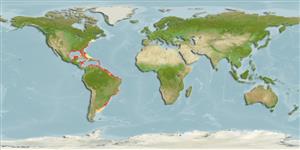Environment: milieu / climate zone / depth range / distribution range
Ecologia
marino; salmastro demersale; distribuzione batimetrica 1 - 53 m (Ref. 9710). Subtropical; 46°N - 45°S, 98°W - 33°W
Western Atlantic: Canada (Ref. 5951) to Maine to Florida, USA (possibly from Nova Scotia, Canada), along coasts of central and south America (Ref. 26938) to Uruguay, including Bermuda and Gulf of Mexico (Ref. 9626). Rare in Greater Antilles (Ref. 26938).
Size / Peso / Age
Maturity: Lm ? range ? - ? cm
Max length : 48.3 cm TL maschio/sesso non determinato; (Ref. 9626); common length : 35.0 cm TL maschio/sesso non determinato; (Ref. 5217); peso massimo pubblicato: 2.1 kg (Ref. 40637)
Spine dorsali (totale): 9; Raggi dorsali molli (totale): 23; Spine anali 3; Raggi anali molli: 18. Pelvic fin small.
Adults are found in shallow coastal waters, usually over hard or sandy bottoms. Juveniles may be encountered in estuarine areas (Ref. 9626) and off sandy beaches (Ref. 5217). Found in schools, but may be encountered in small groups or in pairs (Ref. 26235). Adults feed on small crabs, shrimps, fishes, and worms. Flesh has excellent flavor (Ref. 5521). Marketed fresh (Ref. 9710).
Life cycle and mating behavior
Maturità | Riproduzione | Deposizione | Uova | Fecundity | Larve
Robins, C.R. and G.C. Ray, 1986. A field guide to Atlantic coast fishes of North America. Houghton Mifflin Company, Boston, U.S.A. 354 p. (Ref. 7251)
IUCN Red List Status (Ref. 130435)
Threat to humans
Reports of ciguatera poisoning (Ref. 30911)
Human uses
Pesca: scarso interesse commerciale; Pesce da pesca sportiva: si; Acquario: Acquari pubblici
Informazioni ulteriori
Nomi ComuniSinonimiMetabolismoPredatoriEcotossicologiaRiproduzioneMaturitàDeposizioneSpawning aggregationFecundityUovaEgg development
Strumenti
Special reports
Download XML
Fonti Internet
Estimates based on models
Preferred temperature (Ref.
123201): 11.8 - 27.9, mean 24.2 °C (based on 648 cells).
Phylogenetic diversity index (Ref.
82804): PD
50 = 0.5039 [Uniqueness, from 0.5 = low to 2.0 = high].
Bayesian length-weight: a=0.01288 (0.01139 - 0.01457), b=2.94 (2.91 - 2.97), in cm total length, based on LWR estimates for this species (Ref.
93245).
Trophic level (Ref.
69278): 4.3 ±0.4 se; based on diet studies.
Resilienza (Ref.
120179): Medio, tempo minimo di raddoppiamento della popolazione 1.4 - 4.4 anni (Preliminary K or Fecundity.).
Fishing Vulnerability (Ref.
59153): Moderate vulnerability (38 of 100).
Nutrients (Ref.
124155): Calcium = 98.3 [55.1, 209.5] mg/100g; Iron = 1.33 [0.75, 2.58] mg/100g; Protein = 19.2 [17.4, 21.5] %; Omega3 = 0.43 [0.26, 0.73] g/100g; Selenium = 22 [12, 45] μg/100g; VitaminA = 10 [3, 30] μg/100g; Zinc = 0.709 [0.507, 1.020] mg/100g (wet weight); based on
nutrient studies.
